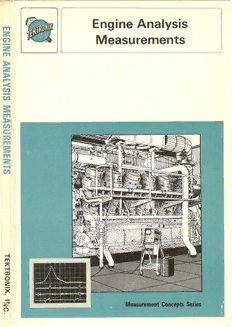
Engine Analysis Measurements PDF
Preview Engine Analysis Measurements
1 Engine- Analysis m 2 - Measurements C") 2 m l> 2 l> !< - en en S m J:a fn ~I m :s: m 2 -t en -I m " -I ::a c:> :-2 X ~- '"r,..." . Measurement Concepts Series C') . • i 1 Engine- Analysis m :2 - Measurements C'l 2 m l> 2 l> !< - en en S m J:a, cn ~I m s: m 2 -I en -I m " -I :a C) :-2 X ~ Measurement Concepts Ser"es ENGINE ANALYSIS BY JIM THURMAN ILLUSTRATIONS BY DICK WILSON MEASUREMENT CONCEPTS FIRST EDITION SECOND PRINTING MARCH 1970 062-1074-00 PRICE $1.00 © 1969, TEKTRONIX, INC. BEAVERTON, OREGON ALL RIGHTS RESERVED CONTENTS INTRODUCTION 1 1 IGNITION SYSTEMS 3 2 IGNITION WAVEFORM ANALYSIS 17 3 MAGNETIC TRANSDUCER 41 4 ROTATIONAL FUNCTION GENERATOR 49 5 VIBRATION TRANSDUCER 63 6 PRESSURE TRANSDUCER 71 APPENDIX A 101 APPENDIX B 113 INDEX 119 VIBRATION MAGNETIC TRANSDUCER TRANSDUCER 1 INTRODUCTION The Tektronix Engine Analyzer is capable of displaying five waveforms; ignition, crank angle markers, magnetic pulses, vibration, and pressure waveforms. The ignition waveform is obtained with the Ignition Probe, the crank angle markers are provided by the Rotational Function Generator, the magnetic pulses are generated by the Magnetic Transducer, the vibration waveforms by the Vibration Transducer, and the pressure waveforms are generated by the Pressure Transducer and are displayed through the Charge Amplifier (Channel 1 of the 3A74 Engine Analyzer Amplifier) . These waveforms can be most useful in determining the condition of the mechanical and electrical components of the engine. Each of the waveforms will be discussed individually, as much as is practical, in the first part of this text. The latter part will be devoted to a discussion of the display and analysis of all the waveforms simultaneously. It is not the intent of this text to illustrate waveforms for any particular malfunction relating to a specific engine. It is, instead, the intent to illustrate basic concepts that can be applied to any engine. 2 Fig. 1-1. Low-tension ignition system. Fig. 1-2. High-tension ignition system (high-voltage distribution) . 3 IGNITION SYSTEMS The purpose of an ignition system on a spark-ignited engine is to deliver an arc at the spark plug electrode gap at the precise moment it is needed to begin the burning or combustion process in the cylinder. Ignition systems are divided into two basic groups: high tension High-tension and low-tension (refer to Figs. 1-1 and low tension 1-2). The terms refer to a voltage level at the time of distribution. In a high-tension system, the energy is distributed to the spark plugs as a high voltage and usually uses a single transformer. In a low-tension system the energy is distributed as a low voltage and is transformed into high voltage at or near the individual spark plugs, thus requiring mUltiple transformers. Several different schemes have been used over the years to achieve the basic purpose of the system. One system that probably has been used more than any other is the "standard" inductive storage system that is used on most automobiles. Other types of ignition systems in use today are magneto, transistor, pulse generator and capacitive discharge. 4 INDUCTIVE STORAGE Because of its wide-spread use the inductive storage system will be discussed first. In the inductive storage system, when the spark plug is not being fired, the points are closed (refer to Figs. 1-3 and 1-4). With the points closed, the current system is effectively a short circuit to ground and, creates therefore, a high current flows in the primary magnetic windings of the transformer (coil). The current is field usually on the order of four or five amperes. The high current in the primary of the transformer causes a rather large field to be present. When it is time to fire the spark plug, the points are opened by a lobe on the distributor cam, breaking the current path to ground. With the disruption of the primary current flow, the magnetic field present in the transformer begins to collapse. high The high rate of change of the magnetic field will voltage generate a high voltage in the secondary due to the generated 100:1 turns ratio of the transformer. This voltage is directed to the proper spark plug by the rotor and distributor cap electrodes. When the potential reaches sufficient amplitude to ionize the atmosphere present at the spark plug gap, spark an arc will begin. With ionization of the gap the gap resistance of the current path is much lower and ioni zation therefore the voltage will drop back to a lower value. The arc will be sustained until the secondary no longer has enough energy to maintain the arc across the gap. At this time the arc will cease and the energy remaining will be dissipated in the form of oscillations in the "tank" or resonant circuit between the capacitor and the primary of the transformer (refer to Fig. 1-4). Sometime later the points are allowed to close as the cam lobe continues its rotation and the cycle begins again. Fig. 1-4 is a drawing of the waveform as it is generated in the secondary circuit of the inductive storage high-tension system. Fig. 1-3 is a simplified schematic diagram of such a system.
